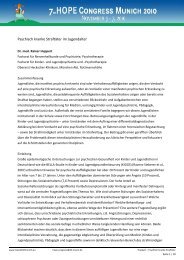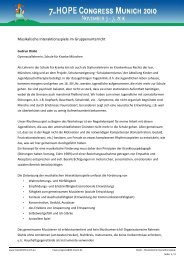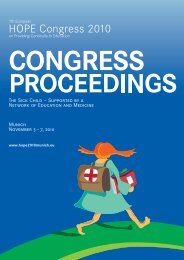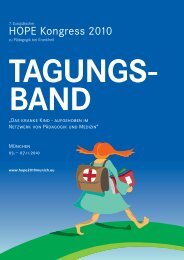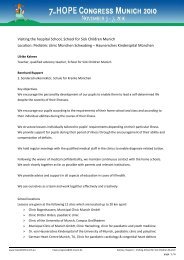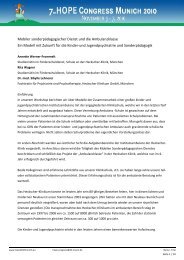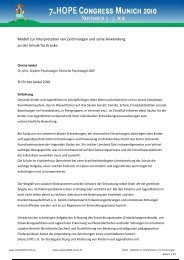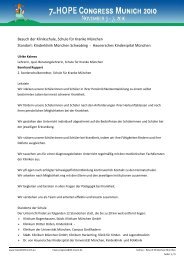HOPE Kongress 2010 - Hope Congress Munich 2010
HOPE Kongress 2010 - Hope Congress Munich 2010
HOPE Kongress 2010 - Hope Congress Munich 2010
Sie wollen auch ein ePaper? Erhöhen Sie die Reichweite Ihrer Titel.
YUMPU macht aus Druck-PDFs automatisch weboptimierte ePaper, die Google liebt.
7th European <strong>HOPE</strong> <strong>Congress</strong> <strong>2010</strong><br />
Living Karaoke - Freue dich an etwas Musik und komm in die Band!<br />
Ein Modell für die Beteiligung von Schülern im Krankenhaus am<br />
Musizieren als Orchester<br />
Klas Brunander<br />
Schulleiter, Linköping, SCHWEDEN<br />
Elisabeth Karelid<br />
Lehrerin, Linköping, SCHWEDEN<br />
Nina Lindberg<br />
Lehrerin, Linköping, SCHWEDEN<br />
Ronny Nordenjack<br />
Lehrer, Linköping, SCHWEDEN<br />
Die Krankenausschule Linköping in Schweden hat über die Jahre verschiedene<br />
Methoden entwickelt in den Fächern Kunst und Musik.<br />
In Musik gibt es zwei Unterrichtsstunden pro Woche. Dabei musizieren<br />
wir als Orchester, wobei sich die Schülerinnen und Schüler je nach Können<br />
und Interesse beteiligen. Sie übernehmen die Rolle des Schlagzeugers,<br />
des Gitarristen, Cellisten oder spielen ein anderes Instrument. Viele sind<br />
glücklich, wenn sie als Sänger oder im Chor mitmachen können.<br />
Man kann sagen, es entsteht ein lebendiges Karaoke. Es hat eine sehr gute<br />
Wirkung auf die Schüler, und auch auf andere Besucher unserer Schule.<br />
Unsere Grund-Idee ist es, Schüler im Musikzimmer zu haben und wir als<br />
Lehrer singen und spielen zusammen mit ihnen. Wir einigen uns darauf,<br />
was wir singen wollen.<br />
In unserem Workshop in München spielten wir Musik von ABBA, den Beatles,<br />
Cash, usw.<br />
Das Erstaunliche ist, wie viel Freude es macht zu spielen und zu singen.<br />
Wir glauben, dass Musik einen sehr wertvollen Beitrag leisten kann bei der<br />
Genesung der Schülerinnen und Schüler.<br />
For the Best - a participatory arts project<br />
Manuela Beste<br />
Headteacher, Evelina Hospital School, London, UK<br />
Following are excerpts from a report about a year long collaboration between<br />
Evelina Children’s Hospital School, the Unicorn Theatre, primary<br />
schools and artists and performers in London, conceived by artist Mark<br />
Storor and produced by educationalist Anna Ledgard. For the Best was<br />
largely funded through a Wellcome Trust Arts Award as part of a public<br />
engagement strategy to support projects that aim to inform and inspire<br />
the public about biomedical science and its social contexts.<br />
The project provided a model of interdisciplinary partnership and collaboration<br />
across multiple agencies including a hospital renal unit, a hospital<br />
school, a theatre, primary schools, artists, a film maker and performers<br />
from a range of disciplines. The project has had a number of profound<br />
outcomes for participating children and families, their peers in primary<br />
schools, bio-medical and education professionals and the general public<br />
audiences for the performance.<br />
Project Activity<br />
From September 2008 Mark Storor worked as artist in residence on the<br />
Dialysis Unit with the children, hearing their stories, enabling them to<br />
create poems and to make images and entering into a reciprocal creative<br />
process with them. A team of artists worked to support the work in the<br />
school, bringing animation, sound recording and making skills to give form<br />
to the children’s ideas.<br />
Along with one of the children from the Unit Mark also devised an imagined<br />
journey drawn from images and writing the child had created that<br />
were metaphorical representations of<br />
his experience of his condition. This journey, named Out of Bounds, included<br />
a maze that had to be travelled through without crossing the bound-<br />
III. Workshops und Foren<br />
107<br />
aries, a meeting with a tiger whose fierceness had to be subdued and an<br />
impossible jigsaw that had to be completed blindfolded.<br />
Responding to letters sent from this child, children at Worple School and<br />
at Charles Dickens School had to travel on the Out of Bounds journey and<br />
rise to the challenge of facing difficulties and hardships in collaboration<br />
with each other in order to succeed.<br />
A team of 6 performers took part in a 6 week devising and rehearsal process<br />
in May 2009 which resulted in the creation of an 80minute piece of<br />
theatre for public audiences. The<br />
stories of the children in the dialysis unit were the source material for<br />
the devising process and, under the guidance of Mark Storor, artists and<br />
performers kept to the essence of these stories, going back to the source<br />
material all the time, whilst bringing their own experience to it, and making<br />
something new and fresh.<br />
The performance of For the Best took place in the Clore studio, corridors<br />
and backstage areas of the Unicorn Theatre. It was attended by mixed audiences<br />
of adults and children – a total of 2,000. The show received excellent<br />
reviews, including a 5 star review in The Guardian, and was pick of the<br />
week in Time Out. The performance was accompanied by other events:<br />
a post-show talk organized in collaboration with London Arts in Health<br />
Forum (attended by 40 delegates); a masterclass for young performers<br />
(attended by 15); and a Symposium at City Hall (attended by 90 delegates).<br />
Opening Workshop<br />
Each workshop began with the participants making a drawing of their physical<br />
self whilst blindfolded. Translating the sensate experience of the<br />
body into a visual image without seeing what is being created provided a<br />
safety for those involved by removing the hesitancy that can come with<br />
expectations of making a recognisable representation. It also signalled<br />
a shift from a focus on the external world to the unique inner landscape<br />
of each participant that would deepen as the workshop progressed. The<br />
next activity encouraged a shift in language use from discursive to expressive<br />
mode. Storor asked participants to identify themselves with objects,<br />
landscapes; creatures etc.<br />
As in: If you were an animal what would you be?<br />
The responses were personal and private and at no time were any of the<br />
participants asked to explain their choices. This shift to expressing self<br />
perception through metaphor then provided the source of the visual images<br />
in the next stage of the workshop.<br />
Each of the participants then drew round a partner to provide them with a<br />
life sized outline of themselves. This outline was then filled with the images<br />
created earlier using whatever materials participants chose from the<br />
rich array of resources Mark Storor provided.<br />
Evelina Hospital School - The Children’s responses<br />
Child J (girl aged 15)<br />
I am a creative pepper, rich, green, smooth and bright<br />
Belonging to a sisterhood of richly coloured, lushly textured peppers:<br />
red, orange, yellow, green<br />
However, slice into my core, and deep<br />
inside my core is dark purple.<br />
My feelings, heartfelt emotion, lies in deep.<br />
I peer into the deep darkness<br />
and recognise a vein of purple jealousy stirring<br />
I push it deeper<br />
Amongst the other tubes<br />
My purple heart core<br />
Although limited make note<br />
Restricted intake – drops<br />
Limited water passes my lips but I am water.<br />
Open, clear, crystal cold, a fountain of reflection<br />
comes to those who gaze into me.<br />
Water holds memory – mix water to substance and<br />
It can ….change things




